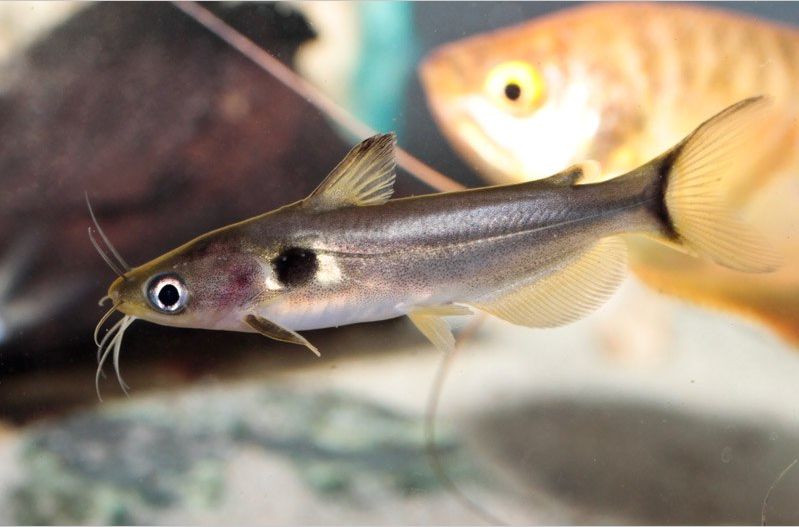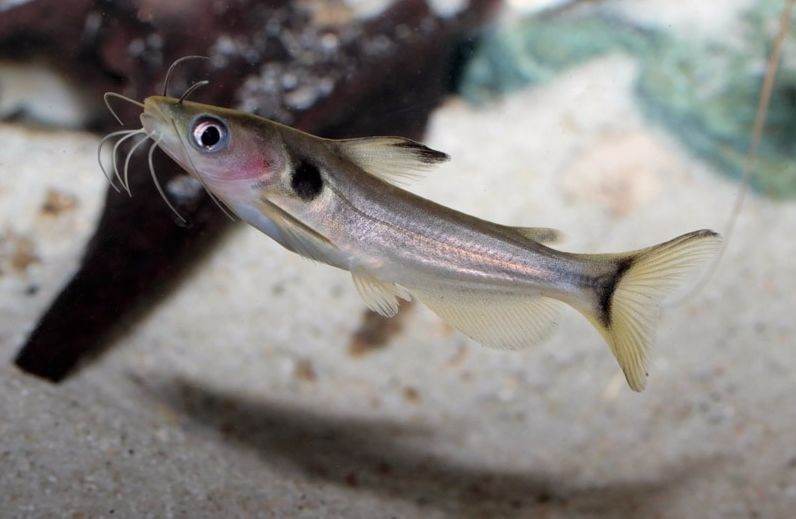The sun catfish, commonly known as the eclipse catfish, is increasingly popular in home aquariums. However, it’s important to recognize that this species may not be suitable for all fishkeepers. This article explores the potential size of the sun catfish and the types of fish or other aquatic creatures that may be at risk when housed with it.

Contents
Habitat in the wild
Horabagrus brachysoma, commonly known as the sun catfish, is a freshwater species native to India. It belongs to the small family Horabagridae, which includes several species. The sun catfish primarily inhabits the waters of Kerala, especially in backwater areas such as Vembanad Lake and the Periyar and Chalakudy Rivers. These fish prefer densely planted areas with slow-moving waters, typically found in lowland river systems with muddy or sandy bottoms, creating ideal living conditions.
Sun catfish have a diverse diet that includes insects, mollusks, and small fish. Adult individuals can consume ground insects, frogs, and even small vertebrates, making their diet very flexible. This adaptability is crucial in a fluctuating environment where food availability can vary significantly due to seasonal changes and monsoon rains. Studies show that sun catfish become particularly gluttonous during their spawning period and in the months following the monsoon, which can significantly influence their behavior and growth.
Sun catfish are also known for their nocturnal activity, making them interesting for aquarists. They use their sensitive whiskers to search for food in the dark and can be quite playful when kept in the right environment. However, it is important to note that their aggressive behavior towards other tank mates can become problematic, especially when housed with smaller or more docile species.
| Scientific Name | Horabagrus brachysoma |
| Family | Bagridae |
| Common Names | Sun catfish, eclipse catfish |
| Range and habitat | India |
| Size | 45 centimetres (18 in) |
| Lifespan | 10 years |
| Ease of keeping | Easy |
| Minimum tank size | 50 gallons |
| Temperament | Predator |
| Diet | Omnivorous |
| Temperature | 73-77 °F (23-25 °C) |
| pH | 6.0-7.5 |
| Water hardness | 5-20 dGH |
Difficulties in keeping
It is an undemanding fish. However, it won’t do for community tanks. Firstly, this is a predator fish, which will prey on its tank mates. Secondly, the sun catfish becomes more active in the evening and at night, while it prefers hiding during the day.
Description
Body
The sun catfish (Horabagrus brachysoma) features a distinctive appearance characterized by its large head and prominent eyes. It has four pairs of barbels: two pairs located on the upper jaw, one pair on the lower jaw, and another pair at the corners of its mouth. These sensory structures help the fish locate food in its murky habitat. The body of the sun catfish is primarily yellow, adorned with a notable black spot near its pectoral fins, which serves as a form of camouflage against predators and enhances its attractiveness in aquarium settings.
Lifespan
The lifespan of the sun catfish can vary significantly based on environmental conditions, care, and genetics. Generally, catfish species are known for their relatively long lifespans compared to many other freshwater fish. Under optimal conditions and with proper care in captivity, sun catfish can live between 10 to 15 years, and some individuals may even exceed this range. In their natural habitat, however, their lifespan is influenced by various factors, including predation, availability of food, water quality, and human activities such as pollution and habitat destruction. The presence of suitable hiding spots and a balanced diet can also contribute to their longevity.
Size
There is a misconception online that sun catfish are small fish, typically cited as growing to about 13 cm (5 inches). Many aquarists may perceive them as small due to this misleading information, but in reality, sun catfish can reach impressive sizes. In the wild, they can grow up to 45 cm (18 inches) in length, while in captivity, they typically reach around 30 cm (12 inches). This size difference highlights the importance of providing adequate space and care in an aquarium setting, as a smaller tank can restrict their growth and lead to health issues.

Keeping in a tank
Tank Size
The tank size required for sun catfish varies based on their age and size. Since these fish can grow to be around 10 to 12 inches (25 to 30 centimeters) in length, they require a spacious aquarium that provides adequate swimming space.
As a general guideline, a minimum tank size of 50 gallons (approximately 190 liters) is recommended for a single adult sun catfish. However, larger tanks are always preferable; providing more space can enhance the overall well-being and health of the fish. In addition, if you plan to keep multiple sun catfish in the same tank, it’s essential to increase the tank size accordingly and include plenty of hiding places and territories for each fish. This setup helps reduce potential aggression, as sun catfish can exhibit territorial behavior.
Decor
Sun catfish are nocturnal creatures, so creating an environment that mimics their natural habitat is crucial. Dim lighting and plenty of shelters are essential for their comfort. Incorporate various decorations such as driftwood, caves, and rocky formations to create hiding places where they can feel secure and reduce stress.
Subdued lighting is vital, as bright lights can lead to stress for these fish. Arrange the decor in a manner that allows open swimming spaces while ensuring ample sheltered areas. This setup encourages sun catfish to explore their surroundings while still providing safe retreats when needed.
Water Parameters
Maintaining appropriate water parameters is critical for the health of sun catfish. The recommended tank water parameters include:
- Temperature: Sun catfish thrive in warmer water, ideally between 75°F to 82°F (24°C to 28°C).
- pH Level: The pH should be slightly acidic to neutral, around 6.5 to 7.5.
- Water Hardness: They do best in soft to moderately hard water, with a recommended hardness range of 5 to 15 dGH (degrees of General Hardness).
In terms of ammonia, nitrite, and nitrate levels, ammonia and nitrite should be undetectable, as they are harmful to fish. Nitrate levels should be kept below 40 ppm (parts per million) to avoid stress.
Adequate filtration is essential to maintain good water quality and manage ammonia and nitrite levels. Regular water changes are necessary to remove accumulated waste and stabilize water parameters. Sun catfish also prefer well-oxygenated water, so ensuring proper aeration and water movement is beneficial. Regular testing of water parameters using reliable test kits is crucial to provide a healthy environment. Always be cautious with sudden changes in water parameters, as rapid fluctuations can stress the fish and jeopardize their health.
Diet
The sun catfish (Horabagrus brachysoma) is an omnivorous species, consuming both plant and animal matter. In their natural habitat, their diet consists of various small aquatic organisms.
Common items in the sun catfish diet include:
- Fish: As predator fish, they prefer live fish and are known to hunt smaller species.
- Insects: Sun catfish feed on various insects and their larvae, such as mosquito larvae, small beetles, and aquatic bugs.
- Crustaceans: They also consume small crustaceans like shrimp and small crayfish.
In captivity, providing a well-balanced diet is essential for the health and vitality of sun catfish. Suitable diets consist of high-quality commercial fish pellets or flakes specifically formulated for omnivorous catfish. Additionally, offering occasional live or frozen foods, such as bloodworms, brine shrimp, or small pieces of fish, can provide variety and essential nutrients, promoting optimal growth and health.

Tank mates
The sun catfish is frequently marketed as a suitable fish for community tanks; however, it’s essential to understand their true nature before mixing them with other species. These catfish are opportunistic feeders and will consume anything they can swallow, making it crucial to avoid keeping them with small-sized fish. Their tank mates should ideally be of the same size or larger to prevent predation.
The best tank mates for sun catfish include large cichlids and other robust catfish species. Large cichlids, such as Oscars or Jack Dempsey cichlids, can coexist well due to their similar temperaments and size. Additionally, other catfish species, like the clown or pleco catfish, can make compatible companions.
Young sun catfish often thrive in the company of their own kind and can form schools, displaying interesting social behaviors. However, as they mature, they tend to prefer solitude, especially during their reproductive phase. Adult sun catfish may become more territorial, and providing adequate space and hiding spots is essential to reduce stress and aggression in the tank.
Here are some suitable tank mates for sun catfish:
- Bottom-dwelling Fish: Since sun catfish primarily inhabit the bottom of the aquarium, consider adding bottom-dwelling species like Corydoras catfish or other catfish species like hoplo catfish.
- Peaceful Cichlids: Certain peaceful cichlids, like blood parrot, can coexist with sun catfish if the tank size is appropriate and there are enough hiding spots.
- Peaceful Loaches: Certain loach species, like clown loaches, can make good tank mates, as they tend to be peaceful and occupy different levels of the aquarium.
Gender Differences: Male vs. Female
Distinguishing between male and female Horabagrus brachysoma can be somewhat challenging, especially when they are young. As they mature, subtle differences may become more apparent. The following characteristics can help differentiate between male and female sun catfish:
- Size: In some cases, males may grow slightly larger than females, but this is not a reliable method for sexing them, as size can vary significantly among individuals.
- Coloration: In many species of catfish, males exhibit brighter or more vibrant coloration than females, especially during the breeding season. However, this difference may not be as pronounced in sun catfish, making it a less reliable indicator.
- Papillary Organs (Genital Papilla): In mature fish, males may have a more pointed or pronounced genital papilla located near the anal fin, while females typically have a rounder and less prominent papilla. Observing this feature can be difficult without experience or close examination.
Breeding
Currently, there is limited information available regarding successful breeding of sun catfish in captivity. While breeding behavior has been observed in their natural habitat, replicating these conditions in an aquarium setting poses challenges.
Sun catfish are believed to spawn during specific times of the year, often coinciding with seasonal changes and monsoon rains, which may influence their reproductive cycles. In the wild, they prefer to spawn in areas with dense vegetation where eggs can be hidden from predators.
If attempting to breed sun catfish in captivity, it’s essential to provide a suitable environment that mimics their natural conditions. This includes creating ample hiding spots and ensuring stable water parameters that promote breeding behavior. Observing potential breeding pairs for courtship behaviors can also be an important part of the process.
Overall, successful breeding of sun catfish remains a complex endeavor that requires specific knowledge and environmental conditions, often best achieved by experienced aquarists.